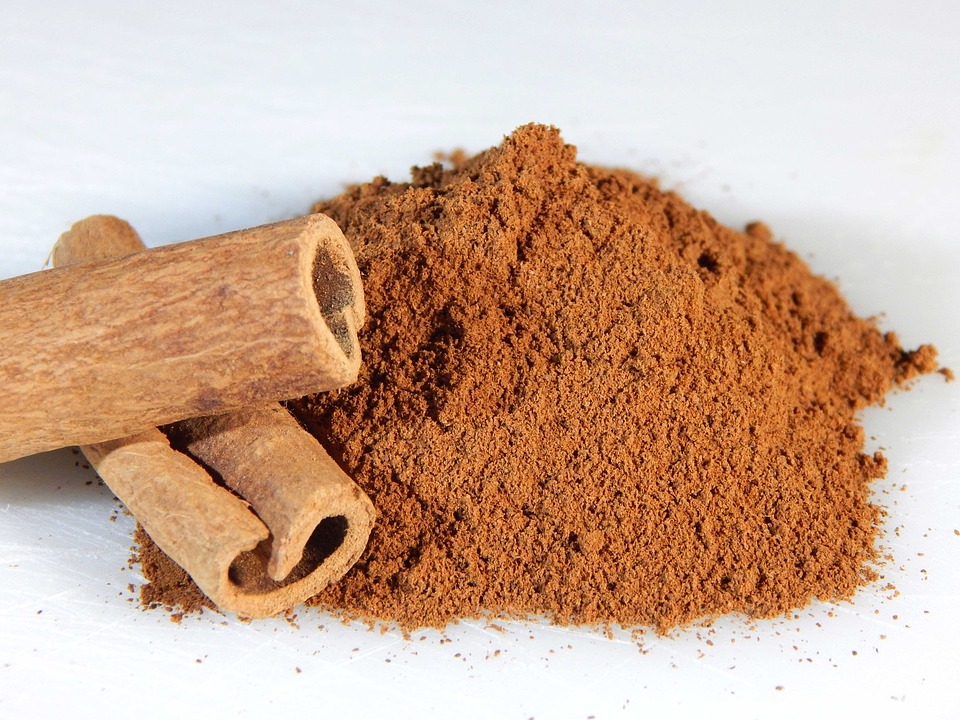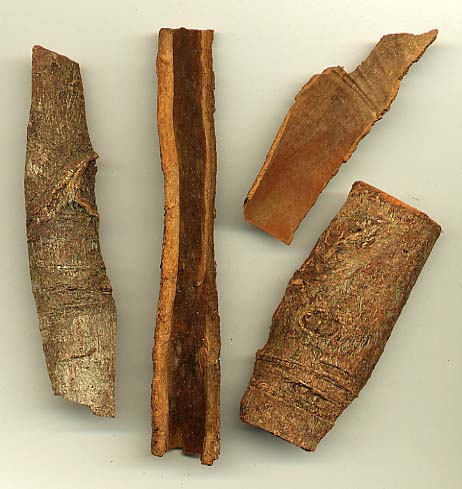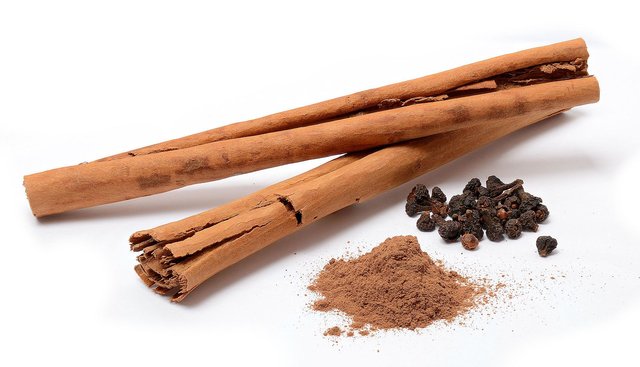I have to admit that I really love cinnamon (its taste and fragrance) and use it as spice in rice pudding, cookies, on waffles and in different kinds of teas. Even the operating system of my laptop is called 'Linux Mint Cinnamon'. :-)

Source: pixabay
Benefits of consuming cinnamon
Cinnamon aficionados won't get tired to point out several health benefits associated with this condiment. I just name a few now:
-
Hoehn and Stockert showed that daily cinnamon supplements caused a statistically significant decrease in the blood sugar levels of type II diabetics.[1] As some of the positive changes lasted even when the probands didn't take supplements anymore, Stockert assumed that one of the proteins involved in gene expression had been affected by cinnamon.[2]
Her hypothesis is that one of the various polyphenolic compounds of cinnamon could be responsible for the positive impact by binding at the protein Sirtuin-1 (or Sirt-1; an enzyme which affects insulin regulation). Utilizing a computer model the female researcher and colleagues tested if the polyphenolic ingredients of cinnamon may have a similar effect like the antioxidant component of red wine, resveratol, which is able to activate Sirt-1 and in addition is believed to have anti-aging and cholesterol-lowering qualities.
According to the results of the computer simulations some of the cinnamon components showed even stronger interactions with Sirt-1 than resveratol.[3] “If cinnamon interacts with this enzyme in the way our model suggests, it could possibly be linked to anti-aging, antioxidant control, a lot of really important health benefits” Stockert says.[2] -
In a fantastic article @justtryme90 just recently pointed out that cinnamon could play an important role in fighting against obesity. But just read yourself.[4]
-
It even looks like cinnamon could increase the ability to learn. Scientists at Rush University Medical Center in California observed that a metabolic product of cinnamon, sodium benzoate[5] changed bad learning mice into good learners.[6] In hippocampal neurons of fast learners the concentration of CREB (a protein involved in learning and memory) is higher than in the hippocampus (the memory storage of our brain) of poor learning rodents. However sodium benzoate (beside other impacts) stimulated the activation of CREB in the brains of the slow learning mice via protein kinase A (PKA) causing an upregulation of various molecules which increase hippocampal plasticity and thus the ability to learn and memorize new things.
-
If that was not enough to convince you, I suggest you to read the review about cinnamon by Pasupuleti Visweswara Rao and Siew Hua Gan based on a large amount of literature on cinnamon from 1982 to 2013. The list of possible benefits is indeed impressive: "In addition to being an antioxidant, anti-inflammatory, antidiabetic, antimicrobial, anticancer, lipid-lowering, and cardiovascular-disease-lowering compound, cinnamon has also been reported to have activities against neurological disorders, such as Parkinson's and Alzheimer's diseases."[7] Hmmm, OK, enough read, where did I put the box of cinnamon again? Let's eat some cinnamon before continuing to write my article ... :-)
Potential risk of eating (too) much of that spice
Unfortunately beside all these positive effects of cinnamon there is also one possible bad one: beside many other interesting active agents this condiment contains also coumarin.[8]
This molecule is known for its hepatotoxic and carcinogenic properties if consumed in high doses. Based on animal hepatotoxicity data the European Food Safety Authority determined a tolerable daily intake (TDI) at a value of 0.1 mg/kg body weight. However, as clinical data showed a subgroup of the human population (for still unknown reasons) reacts more sensitive to coumarin than the investigated animal species and thus has a higher risk of liver damages.[9]
|
That's cinnamic acid (or 3-Phenylacrylic acid, C6H5CHCHCOOH)[10] with an aromatic ring on the left side and the typical carboxyl group (-COOH) of carboxylic acids on the right side.
|
And that's coumarin (C11H6O2). You can see the two planar aromatic[11] rings, where one of them is heterocyclic because it contains not only C atoms but also an O atom.
|
By the way coumarin cannot only be found in cinnamon but also in some other plants, for example in 'sweet woodruff' (Galium odoratum[12]). The delicious May wine (Maibowle) flavoured by 'sweet woodruff' gets its aroma from the coumarin component as well.
Galium odoratum:

Does the ingredient coumarin spoil the 'cinnamon party'?
Well, if you are ready to pay somewhat more money you may be allowed to eat more cinnamon, too (as always the world seems to be made for the rich people ...): actually there are two kinds of commercially available cinnamon plants, the very frequently offered and cheaper 'Chinese cinnamon' (Cinnamomum cassia[13]) and the rare and more expensive 'Ceylon cinnamon' (Cinnamomum verum[14]).
On the left side you see the bark of Cinnamomum cassia, on the right Cinnamomum verum.
|
|
|
While Cinnamomum cassia (which originated in Southern China) contains about 1 % coumarin, Cinnamomum verum (native to Sri Lanka and southern parts of India) comprises only 0.004 % (which is 250 times less).[15] Considering that it is much safer to use Cinnamomum verum instead of its relative, especially in case one belongs to the groups of humans which reacts more sensitive than average to coumarin.
Conclusion: if you chose the right cinnamon species the party can continue. :-)
Sources:
- https://www.ncbi.nlm.nih.gov/pmc/articles/PMC3698471/
- http://time.com/4751426/why-cinnamon-is-insanely-good-for-you/
- https://app.core-apps.com/eb2017/abstract/05269568c4077b5a162e9981c2466df5
- https://steemit.com/@justtryme90
- https://en.wikipedia.org/wiki/Sodium_benzoate
- https://link.springer.com/article/10.1007%2Fs11481-016-9693-6
- https://www.ncbi.nlm.nih.gov/pmc/articles/PMC4003790/
- https://en.wikipedia.org/wiki/Coumarin
- https://www.ncbi.nlm.nih.gov/pubmed/20024932
- https://en.wikipedia.org/wiki/Cinnamic_acid
- https://en.wikipedia.org/wiki/Aromaticity
- https://en.wikipedia.org/wiki/Galium_odoratum
- https://en.wikipedia.org/wiki/Cinnamomum_cassia
- https://en.wikipedia.org/wiki/Cinnamomum_verum
- https://authoritynutrition.com/ceylon-vs-cassia-cinnamon/




Pure cure.
Downvoting a post can decrease pending rewards and make it less visible. Common reasons:
Submit
Nice work man!
I don't know if the amount of sodium benzoate that comes from the oxidation of cinnamic acid in the liver is going to result in concentrations greater than would be from just common exposure to that compound. Its a pretty prominently used preservative. On the bright side, Na Benzoate is an exceedingly safe compound which is easily excreted by the kidneys. This article with it's super descriptive and detailed abstract (sarcasm) reports that a 2% solution of it was given to mice with no deleterious side effects.
Side Note about Coumarin, its a really great fluorescent molecule excited by UV light and emitting blue. Very environmentally (due to hydration) sensitive and particularly useful in the study of the molecular motions of proteins.
Downvoting a post can decrease pending rewards and make it less visible. Common reasons:
Submit
Good question ... It may be thinkable that other components of cinnamon amplify its effect or simplify its absorption into the hippocampal neurons ... 'anyhow'? But that's pure speculation from my side.
Downvoting a post can decrease pending rewards and make it less visible. Common reasons:
Submit
Data or I am not convinced. :D
Downvoting a post can decrease pending rewards and make it less visible. Common reasons:
Submit
I am also not convinced. :) I only presented their results. We may message them for further information. :)
Downvoting a post can decrease pending rewards and make it less visible. Common reasons:
Submit
nice...you deserve upvote and resteem...
Downvoting a post can decrease pending rewards and make it less visible. Common reasons:
Submit
Great post! :)
Downvoting a post can decrease pending rewards and make it less visible. Common reasons:
Submit
Downvoting a post can decrease pending rewards and make it less visible. Common reasons:
Submit
yep, you're right. Since I know that there are two versions, I always go for the Cinnamomum verum. Thanks for letting the community know
Downvoting a post can decrease pending rewards and make it less visible. Common reasons:
Submit
Thanks for sharing !!
Downvoting a post can decrease pending rewards and make it less visible. Common reasons:
Submit
schön, mit was du dich alles beschäftigst.....hihi
Downvoting a post can decrease pending rewards and make it less visible. Common reasons:
Submit
:-)
An diesem vermaledeiten Wochenende habe ich mich vor allem mit dem nicht funktionierenden Internet beschäftigen müssen ... scheint jetzt aber (hoffentlich) wieder zu gehen ...
Downvoting a post can decrease pending rewards and make it less visible. Common reasons:
Submit
ohh nein.. ich hatte auch keins.... aber im garten gibts einfach keins...lol
Downvoting a post can decrease pending rewards and make it less visible. Common reasons:
Submit
Lovely post. We enjoy cinnamon almost every day, especially since I come from South India... the land of spices. :)
Glad to learn some of these benefits. As to the risks? Heh. We don't believe it has any. Truth though!
Downvoting a post can decrease pending rewards and make it less visible. Common reasons:
Submit
If you are from South India, it is well possible that anyway you use the risk free Cinnamomum verum.
Downvoting a post can decrease pending rewards and make it less visible. Common reasons:
Submit
Super interesting stuff! Now let's all do the tablespoon challenge.
Downvoting a post can decrease pending rewards and make it less visible. Common reasons:
Submit
Excellent post. I knew the positive benefits of cinnamon and put it in my coffee everyday. I will now look to get the healthier version of cinnamon. How much is considered too much that causes higher risks?
Downvoting a post can decrease pending rewards and make it less visible. Common reasons:
Submit
If you don't belong to the specially sensitive group, it is suggested not to ingest more than 0.1 mg per kg body weight. In case of Cinnamomum cassia, just 1 - 2 teaspoons could bring you over the daily limit. However even within this species of cinnamon trees the coumarin concentration seems to differ a lot.
Consuming Cinnamomum verum should be completely safe though (I guess you don't plan to eat masses of it? :-) ).
Downvoting a post can decrease pending rewards and make it less visible. Common reasons:
Submit
Thank you for such a thorough reply. I sprinkle some in several cups of coffee everyday. So it sounds like that is within safe limits.
Downvoting a post can decrease pending rewards and make it less visible. Common reasons:
Submit
i dig spice
Downvoting a post can decrease pending rewards and make it less visible. Common reasons:
Submit
cinnamon is beautiful... thanks for sharing
Downvoting a post can decrease pending rewards and make it less visible. Common reasons:
Submit
nice post
cinnamon is amazing
thanks for sharing
Downvoting a post can decrease pending rewards and make it less visible. Common reasons:
Submit
I agree with your conclusion. Ceylon cinnnamon all the way as Cassia is literally a Chinese knockoff. The current price I pay for the Ceylon cinnamon is $21 Cdn/ kilo.
Downvoting a post can decrease pending rewards and make it less visible. Common reasons:
Submit
"Chinese knockoff" sounds as if anybody was to blame :-) ... but it is just that between these two plants with similar active agents one has less side effects. Therefore you are right of course, and the 'Ceylon version' is more recommendable, especially if you like to eat much of it.
Downvoting a post can decrease pending rewards and make it less visible. Common reasons:
Submit
Great that one of my preferred condiments is so beneficial for health at the same time! :)
Downvoting a post can decrease pending rewards and make it less visible. Common reasons:
Submit
Very informative article! I haven't ever tried this! I like your photo of the little plants from a shady place in your garden! Thanks so much for sharing! ;)
Downvoting a post can decrease pending rewards and make it less visible. Common reasons:
Submit
I love cinnamon and its soo healthy! agree with you! and i always use it in my smoothies!!
Downvoting a post can decrease pending rewards and make it less visible. Common reasons:
Submit
Cinnamon is a great spice and is widely used in Malaysian cooking too.
Downvoting a post can decrease pending rewards and make it less visible. Common reasons:
Submit
I've been hit with Ulcerative Colitis. So I've been looking at different supplements with anti inflammatory properties. Cinnamon seems to be one of those. I posted on the benefits of cinnamon as well.
https://steemit.com/health/@grey580/lemon-honey-cinnamon-water-to-help-lose-weight
Downvoting a post can decrease pending rewards and make it less visible. Common reasons:
Submit
I have been taking this salt product and has helped me a great deal. I am not sure if it will help with Ulcerative Colitis, but it is worth getting in touch with them via this website http://www.wellbeingcreator.com/category_s/12.htm
I hope this sharing of information helps you in some way.
Downvoting a post can decrease pending rewards and make it less visible. Common reasons:
Submit
Good info on the two kinds of Cinnamon!
Downvoting a post can decrease pending rewards and make it less visible. Common reasons:
Submit
Excellent work. Cinnamon tastes delicious on bread with butter
Downvoting a post can decrease pending rewards and make it less visible. Common reasons:
Submit
Cinnamon with coffee for the win. Thanks for sharing this
Downvoting a post can decrease pending rewards and make it less visible. Common reasons:
Submit
can you tell us more about side effects - thank you
Downvoting a post can decrease pending rewards and make it less visible. Common reasons:
Submit
Thank you for the work .
Downvoting a post can decrease pending rewards and make it less visible. Common reasons:
Submit